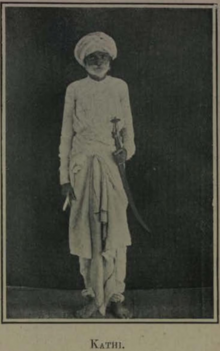
The Kathi people is a small group of clans found in the peninsular Kathiawar (historically called Saurashtra) of Gujarat, western India. It was from the Kathis that the Maratha Empire and later the British Raj renamed the Saurashtra as Kathiawar as the Kathis were prominent there during the 17th-18th centuries. According to A. M. Shah, Kathis are a peasant caste.[1]
Their kuladevatā is the Sun. According to tradition, a Kāṭhī called Vāloji fled from Pāvāgaḍh. He defeated Jām Abdā of Thān with the help of the Sun god, and in return Vāloji repaired the sun temple on Kandolā Hill (originally built by Māndhātā in Satya Yuga). Vāloji's daughter Sonabāi became the priestess of the temple, and married Vālerā Jālu. Sonabāi's descendants, known as Bhagats, form the main sun-worshipping strand of Kāṭhīs.[2]
The Kathis practiced the partition of territory upon a rulers death, in which his territory would be carved out among his sons. However, the British encouraged the practice of primogeniture, in which a ruler's territory would be completely inherited by his eldest son (or whomever was next in succession). The British favored this practice because it was easier to maintain control over a few large states rather than hundreds of small ones. However, by the late 1920s, only a few Kathi rulers had adopted primogeniture.[3][4][5]
- ^ Shah, Arvind (1988). Division and Hierarchy: An Overview of Caste in Gujarat. Hindustan Publishing Corporation. p. 4.
- ^ Bhatt, P. N. (1953). "The Sun-Cult in Gujarat and Saurashtra". Proceedings & Transactions of the All India Oriental Conference: Seventeenth Session, Ahmedabad. All India Oriental Congress. p. 435.
- ^ McLeod, John (1999). Sovereignty, Power, Control: Politics in the State of Western India, 1916-1947. Brill. pp. 13, 196, XI.
- ^ Karve, Irawati (1990). Kinship Organization in India. Munshiram Manoharlal. p. 172.
- ^ International Encyclopedia of Horse Breeds Page 251-252